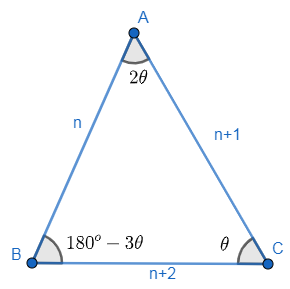Question
Question: The sides of a triangle are three consecutive natural numbers and its largest angle is twice the sma...
The sides of a triangle are three consecutive natural numbers and its largest angle is twice the smallest one, then the sides are
(a) 6, 7, 8
(b) 4, 5, 6
(c) 1, 2, 3
(d) 3, 4, 5
Solution
Hint: Assume the three sides of the triangle in terms of any variable with the difference ‘1’. Now use sine rule to find the length of sides. Sine rule is given as,
asinA=bsinB=csinC.
Complete step-by-step answer:
Let us suppose the sides of the triangle as n, n+1, n+2 because it is given that sides are three consecutive natural numbers.
Now, it is given that the largest angle of the triangle is twice the smaller one.

We know the property of a triangle that the opposite side of the larger angle is greater than the opposite side of the smaller angle.
So, the relation in sides is given as,
nHence, from triangle ABC in the diagram we will get
∠C<∠B<∠A
Let ∠C be θ, hence ∠A would be 2θ, as it is given in the question that the largest angle is twice the smallest one.
So, the angle B can be written as 180o−3θ, by using the property of triangle i.e., sum of all interior triangle is 180∘ always.
Now, we can apply sine Rule in ΔABC which is given as,
n+2sinA=n+1sinB=nsinC
Substituting the corresponding values, we get
n+2sin2θ=n+1sin(180−3θ)=nsinθ..............(i)
Now we can use identities of trigonometric which are given as
sin2θ=2sinθcosθ and sin(180−θ)=sinθ
Hence, equation (i) can be written as,
n+22sinθcosθ=n+1sin3θ=nsinθ
Now, use sin3θ=3sinθ−4sin3θ to further solve the above equation. Hence, we get
n+22sinθcosθ=n+13sinθ−4sin3θ=nsinθ
n+22sinθcosθ=n+1sinθ(3−4sin2θ)=nsinθ
Now, we can divide the whole equation by sinθ , and hence we get
n+22cosθ=n+13−4sin2θ=n1..............(ii)
Now, we can solve the equation (ii) by solving two equations individually, given as
n+22cosθ=n1.................(iii)n+13−4sin2θ=n1.................(iv)
Now, we can get value of cosθ from equation (iii) as
cosθ=21(nn+2)................(v)
We know sin2θ+cos2θ=1, use this identity in equation (iv) to convert ‘sine’ function to ‘cosine’. Hence, we get
n+13−4(1−cos2θ)=n1⇒n+13−4+4cos2θ=n1⇒4cos2θ−1=nn+1⇒4cos2θ=nn+1+1=nn+1+n=n2n+1⇒cos2θ=41(n2n+1)........(vi)
Now put the value of cosθ from the equation (v) in the equation (vi) for getting the values of ‘n’, we get
((21)(nn+2))2=41(n2n+1)
(41(nn+2)2)=41(n2n+1)
n(n+2)2=1(2n+1)
On cross multiplying the above equation, we get
(n+2)2=n(2n+1)
On opening the bracket, we get
n2+4n+4=2n2+n
⇒n2−3n−4=0
Now, we can factorise the above equation by splitting the middle term, i.e., ‘-3’ to ‘-4’ and ‘1’. Hence, we get
n2−4n+n−4=0⇒n(n−4)+1(n−4)=0⇒(n−4)(n+1)=0
Hence,
n + 1 = 0 or n – 4 = 0
n = -1 or n = 4
As n = -1 is not possible. As a side of the triangle cannot be negative and ‘n’ is a natural number as well. So, n = 4.
Hence, sides of triangle can be given as n, n+1, n+2 i.e., 4, 5, 6
So, option (b) is the correct answer.
Note: One can apply cosine formula as well for solving the given question. As cosine formula is given as,
cosθ=2bcb2+c2−a2
Hence,
cos2θ=2n(n+1)n2+(n+1)2−(n+2)2 and cosθ=2(n+2)(n+1)(n+2)2+(n+1)2−n2
Now, solve the above equation to get ‘n’.
Calculation is the important part of the side as well. One may go wrong with the sine rule equation as well. Sine rule is given as
asinA=bsinB=csinC
Here (a, b, c) sides are opposite to the angles A, B, C. So, be clear with the terms in the expression of sine rule.
